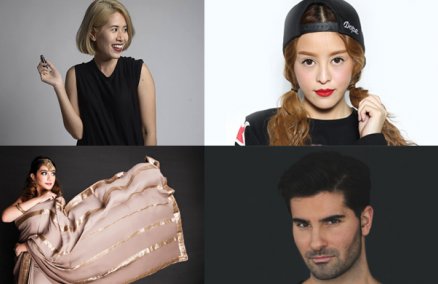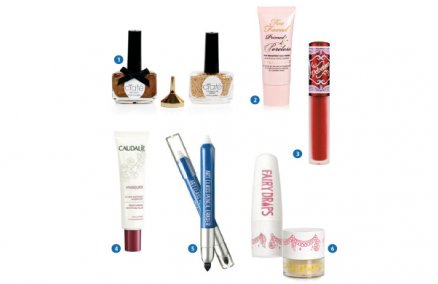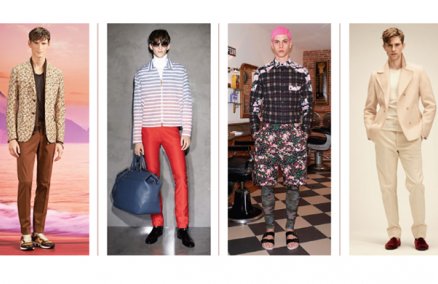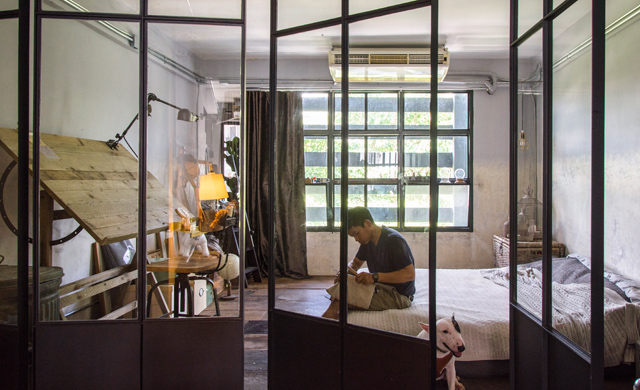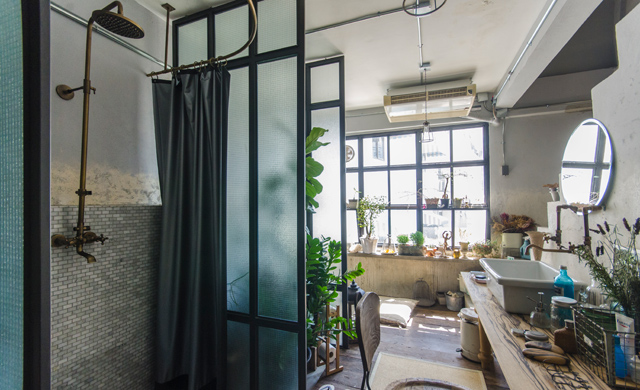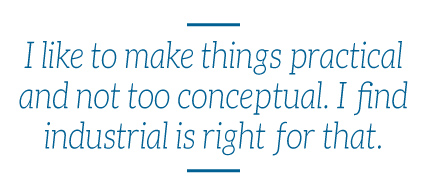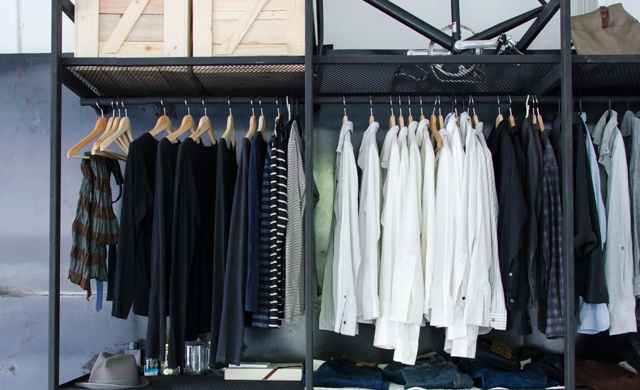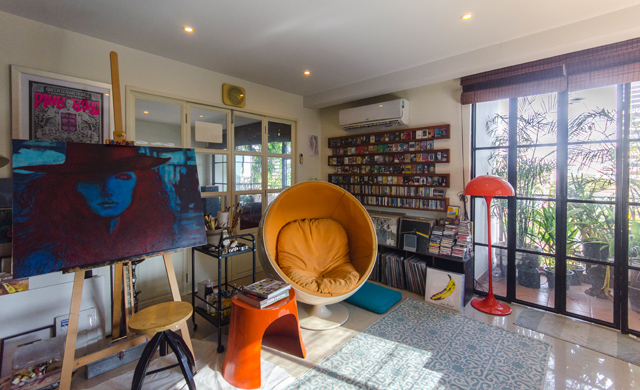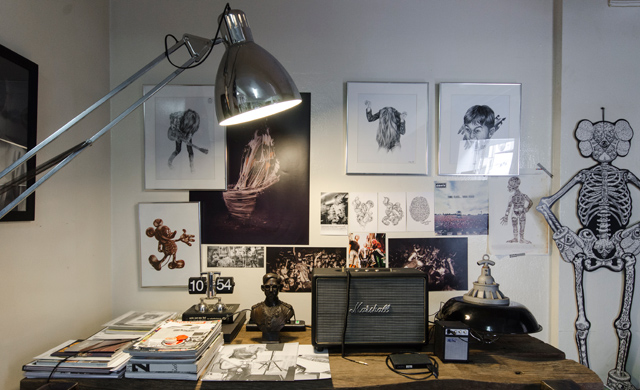Inspired? Get the look with Best Shops for Retro Decor in Bangkok

You can’t deny industrial décor is in vogue right now. Over the past year, it seems that every other new café and restaurant has adopted the bare bricks, black steel and naked bulbs look. One of the venues to kick off the trend was the expansion of Casa Lapin [originally in Thonglor Art Village] to Sukhumvit Soi 49. Here, the Be Grey design team transformed an old shophouse into a hip yet homey loft-inspired café (it helps that they serve great coffee, too). The first two stories are still reserved for the coffee shop, but the fourth floor is now home to one the café’s partners and Be Grey designer, Nattaphat “Lux” Suriyakumphol. We paid Lux a visit and he told us more about why he went with a functional, industrial look for his 48-sq-meter home.
What came first, Casa Lapin or this house?
This building belongs to one of our partners and it used to be rented out as a tailor shop. When they moved out, I became attracted by the location and decided to move in, before we even had the idea of doing Casa Lapin on the first floor.
What was your inspiration behind the design?
We went with industrial because it matched the old exterior. It is an old building that we had to renovate, anyway. When we were playing around with the idea we realized that the place really went well with steel, bricks and unfinished walls—so we liked it more and more. And that’s not only for the café. I noticed that the walls on one side of the room were bare with just one coat of white paint, and it was beautiful, so I redid the others to resemble this, too. Actually, when I do design work for others, it doesn’t always end up in a specific style. We need to work in accordance with customer’s lifestyles and special requests, but I like to make things practical and not too conceptual. I find industrial is right for that.
Speaking of design trends; what do you think is the next big thing?
Interior design is a bit like fashion—things go out of style and eventually make a comeback. Actually, industrial has been in for a while. The style is all about matching it right. The concept and materials are classic, as opposed to other vintage decor themes that contain too many details that can go out of fashion any time. I think this trend will be in for a while yet; but like I said, you need to match it right.
Where do you normally shop for furniture?
I got this sofa made-to-order at Chanintr. I only just installed it. I got my drafting table at Casa Pagoda, while some random items I got at IKEA or flea markets.
For you, what’s the most important part of designing a house?
First, you have to know your lifestyle. Then it’s easy to let your daily activities design the space. For me, I don’t need a big bedroom because sometimes it takes me until 1am to get to sleep. I spend a lot of time in the morning to get ready, and that’s the reason the narrow walkway was designed to be all connected and ended up containing three-quarters of the room. The garden, too, was something I wanted to incorporate into my morning routine. Dividing the space this way means I can water the garden as I get dressed.
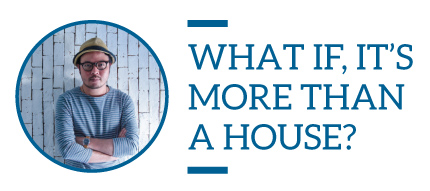
Thanakorn “Ton” Sappakitkamjon, the architect and interior designer from Studio Mixo who just partnered up with friends to open What If Café and Design on Sukhumvit Soi 31, can call Bo.Lan Restaurant on Soi 24 his neighbor. His three-story 60-sq-meter townhouse is now also home to Ton’s small handmade leather workshop, Made By Anan, as well as his home up on the top floor. Ton took us on a tour of his industrial chic abode and also gave us some insight into his forthcoming projects.
What was your original plan for this shophouse?
This three-story townhouse project has taken me over a year to build. After I decided to move out of my place in the Lumpini area, I was looking for somewhere to combine a café, office and house. Then I found this building owned by my friends’ parents, who just decided to lease it out. The first floor is planned to be a bike-friendly café, as I’m a bike lover myself. It will officially open in January next year. The second floor is now a temporary Made by Anan factory, as a partner and I are also building a permanent one in Trad province. Once operations are moved there, the floor will be turned into a weekend workshop.
What’s the inspiration behind the décor?
Industrial design is the hottest trend at the moment and everyone is kind of doing it that way. For me, though, my fascination started with the film Closer (2004), in which Julia Robert plays a photographer who lives in a very nice New York loft house. Photography is one of my interests and the film really encouraged me to want a house like that. Plus, working in interior design helped me get my hands on a lot of rare decorative items, like the World War II-era lamp I got from Rod Fai Market or the navy military steel drawers that I got in an auction at the US Embassy. When it comes to my own space, even if you generally could call it “industrial,” I feel I’ve made it my own.
What is the most enjoyable part about designing a home?
You can do what you want—that’s the first joy. Apart from that, designing this interior also let me try new things, like using steel as my headboard. Some people might warn you off things because they’re not the most practical, but you can still do it if you want. An open closet might get dusty, yeah, but that’s the trade-off for something that looks nice. See all those bricks on the wall? I’ve hardly ever seen anyone lay bricks vertically. I didn’t know if it would work at first but I wanted to try it anyway.
Where do you normally shop?
I used to go to Rod Fai Market a lot but now since I have a good relationship with specific shop owners, it’s a lot easier to get stuff directly from them without having to visit the market all the time. Y50 is another place I like, as well as a bunch of other random places.
For you, what’s the most important part of a house?
When I get to design a house for somebody else, I always tell them to invest in a good bed and sofa. But it all depends on the character and lifestyle of the person. For me, in this place, the living room is everything since I spend most of my time chilling and working here.
On top of founding the Art House art school and working on many projects like the design of Parata Diamond, Chanchalad “Burne” Khanjanawong launched an innovative stationery brand, Grey Ray, for which he was recently awarded Designer of The Year 2013 by the Fine Arts Department. With his own 105-sq-meter apartment on Sukhumvit Soi 85, he has tried to fashion a space which combines his childhood memories of home and his passion for music. We sat down with Burne to talk about how he made his apartment a home.
Why did you decide to buy your own apartment and not a house?
I’ve loved to decorate my room since I was very young. Even when I lived with my big family and everyone had their own room, most people loved to hangout in my room anyway. Living in a house feels lonelier than in an apartment, if you’re staying alone. It’s like you expect someone to be in the room next to you. That’s why an apartment suits my needs better. And this apartment is quite cool: they let you look at the floor plan and change it before construction starts. So I was able to request a connecting terrace.
You’re obviously really into old music memorabilia—why is that?
I was born in 1972 and by the late 70s, my parents had decorated the house in a hippie style, my dad had long hair and wore bell-bottom jeans, my grandparents worked as film dubbers using 35mm film for screenings. These are images I grew up with and they got me into music, art and design. When I got the chance to design my own space, I wanted it to show what I am all about. I wanted to create a room suited to music.
Where do you normally shop?
I get a lot of my vinyl from online shops (like
www.thaigramophone.com) which sell both new and rare records and hold big sales from time to time. For furniture, I like Y50—that’s where I got the 1960s’ Eero Aarnio Ball Chairs. I also got some rare items from Talad Mued [Dark Market, next to Yaowarat] like this retro telephone, which still works.
You studied architecture; what led you to start a stationery brand?
I was inspired by the book written by Farm Chok Chai owner Choke Bulakul, Chok Chuay Doey Prasobkarn, in which he said that his business model is not focused on horizontal growth but more on vertical expansion. Meaning that instead of creating more and more farms, he’d rather expand more businesses from within the original farm. I thought about my art school, Art House; maybe instead of opening more branches, I could invest in products that might help the school run better. That’s how Grey Ray and EE Defender: Pencil Cap came into being.
Are you still doing interior projects?
These last two years I’ve largely stopped. When you work on site, doing interiors is not about designing anymore; it’s more like communicating with people and meeting their demands, and sometimes that gets on your nerves. With my last work, for Parata Diamond, the owner is my junior from university, so I agreed to make an exception.
What is your style when doing interiors for customers?
In general, I don’t have a fixed style, like we were taught to have in architecture school. I love to surprise people, if you can call that a style. Every design I do starts with the taste of who ever I’m designing for, and then I just try to exceed their expectations.

Nestled in the old town, near Pichai intersection, Pichai Apartment is a three-story building that’s home to many writers, stylists and other creative types. The tenants’ easygoing character and the place’s lack of strict rules make it more like a community than a sterile apartment complex, and hence a welcoming place to live. Wuttikorn “Ong” Akkaratanasompop, the executive art director and production supervisor at the Visionary production house and guitarist for the band The Layers, just won a Baan Lae Suan Award earlier this year under the best design category for his room. We caught up with Ong to get the lowdown on how his passion for grunge informed his design.
What was the inspiration behind your design?
Designing a house for me is like doing the display in front of a fashion store. I didn’t plan to have it look exactly like this, but I do like a certain style of furniture: mostly black or white, big wooden pieces with steel. Some of the pieces followed me from my old place. When I moved here, I simply had a look at the space and decided where each piece fitted best. Even if I move out, I imagine my new house wouldn’t be very different from this, depending on the room.
You like made-to-order furniture. Why?
I work in an advertising company where things have to look perfect, life is always a rush and we can never wait for anything. For me, imperfections have their charm. The furniture I buy have their own stories; some are from secondhand shops with little scratches—but I don’t mind that. These items might take you time to find, but it’s worth it. it’s like finding your soulmate. Made-to-order furniture is similiar. You have this piece but you want to add a twist, so you have to wait for it. Sometimes it works out perfectly, other times it’s not exactly what you want but still acceptable. Like my steel bag-hanger: it’s taller than what I wanted. But it doesn’t matter.
Where do you normally shop?
Chatuchak Weekend Market and Rodfai Market, of course. These two are the only places to get really good and unique stuff at cheap prices. Rodfai Market is where I got this wooden table for the terrace, while the huge couch is from Casa Pagoda. But I don’t just go out to shop and buy things on the spot. I like to revisit the shop a couple of times before committing to buy something. When I visit the made-to-order shop, I talk to them like talking to a friend, sharing ideas on what I like and helping draft the pieces up.
Your place is quite far from your office; why live here instead of a new condo by the BTS or somewhere closer to the city?
I love the neighborhood, basically. It’s like, I used to live in the Pinklao area when I studied at Silapakorn University and I stayed there for another four years after graduating. I got used to the peaceful life around here, where there’s a lot of greenery, even if you’re not at the park. The pace of life is a lot slower compared to in town. And as I’ve mentioned, my advertising job is all about rushing: the time you spend on the road is the only time you can be by yourself. For me it takes around 40 minutes to get to work; even then, bad traffic just means more time to listen to music!
















